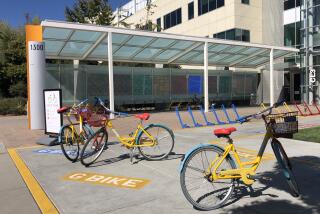Lowest-Common-Denominator Math : Poor Scores Show We’re Failing Test of Technological Society
- Share via
My wife, Joan, ran for the Brookline, Mass., school committee on a platform of “More Math and Science.” She lost to the forces of “Equity not Excellence,” or “Lesson Less for Moron More!”
We Americans aim at the lowest common denominator, and we aim low. Our children’s training in math is scandalous. Our best are not nearly good enough, and most high-school graduates suffer from Acquired Incurable Dysmetria, otherwise known as Fear of Mathematics.
Recent studies establish beyond doubt the relative mathematical illiteracy of American vs. foreign school children from first grade onward. The Feb. 14 issue of Science magazine reports on a comparison of 2,300 pupils from Taiwan, Japan and Minneapolis. As early as first grade, our students have fallen behind their Asian counterparts, and by fifth grade the effect is unmistakable.
A more ambitious study, sponsored by the U.S. Department of Education and involving 6,648 American children as well as students from many other nations, reveals that the disease progresses relentlessly with age. Our eighth graders ranked 13th among the 17 countries studied. Japanese, Dutch and Hungarian students outclassed our children by as much as ours ranked above the Nigerians and Swazilanders.
Ours is a technological society needing mathematically competent workers to man its robots and computers, and realize its high-tech hopes. Another Education Department survey focuses upon the top 5% of students from 12 countries. This time, America comes out dead last. Our very best students, in their senior year at high school, are no better (mathematically) than average students from Finland, and quite inferior to randomly chosen Japanese.
College freshmen, by and large, cannot pursue the professions of their choice. Mathematical literacy is essential for the study of physics, chemistry, mathematics, computer science, engineering, economics, and for premedical or predental programs. How many of our youngsters have been disqualified by the weakness of their pre-college education? Most of them.
America has dozens of first-rate schools for post-graduate study in science and engineering, but not nearly enough qualified American applicants. More than half of our graduate students are foreigners, and the ratio is increasing. Many stay in this country after their studies to take high-paying high-tech jobs, while undereducated Americans sweep their floors and cut their grass.
Why are American students so bad at math? According to Science magazine, “Most American mothers interviewed in this study did not appear to be dissatisfied with their children’s schools . . .. The children, faced with parents who generally are satisfied and approving of what happens in school, must see little need to spend more time and effort on their schoolwork.
The poor performance of American children in mathematics thus reflects a general failure to perceive that American elementary school children are performing ineffectively and that there is a need for improvement and change if the United States is to remain competitive with other countries . . .. “
There are other reasons: Few American teachers understand the math that they are supposed to teach. If they did, they could (and would) earn far more in industry. Textbooks in science and math are often written with explanations that make no sense and problems that cannot be done. As a parent of four children in the public schools, and as a practicing scientist, I know. Then there is television. Is there an American child who spends as much time on homework as he or she does glued to the boob-tube? Not likely. Learning mathematics, like learning the oboe, takes time and practice.
Will things change? Not likely. Despite the warnings sounded in the 1983 presidential commission report, “A Nation at Risk,” the situation has become far more alarming. One by one, our industries fall victim to superior foreign technologies: steel, shoes, stereos, ships, silicon chips, cars, robots, textile and agricultural machinery, and soon, computers and airplanes. No wonder there’s a whopping trade deficit. It’s not the cheap labor nor the strong dollar so much as it is the lack of imaginative engineering or what we once proudly called “know-how.”
Our bright children, excluded by our criminally poor schools from doing anything useful for American technology, are forced into such professions as law and advertising. They will do to you what they did to AT&T; and convince you that you like it.
Meanwhile, the French launch satellites with no loss of life using their unmanned Ariane rockets, the Soviets send us close-up pictures of Halley’s comet, Canadians sell us electricity produced by safe and reliable reactors, Western Europeans find all the elementary particles, and Japanese offer cameras that even Americans can operate. While we can afford the free ride, it’s not a bad deal. But watch out! The yellow brick road of downward mobility doesn’t lead to the land of Oz.
More to Read
Sign up for Essential California
The most important California stories and recommendations in your inbox every morning.
You may occasionally receive promotional content from the Los Angeles Times.













